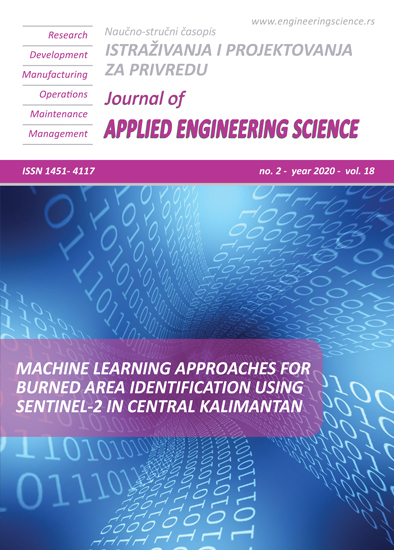INFLUENCE OF THICKNESS AND GRANULOMETRIC COMPOSITION OF GRANULAR ASPHALT ON ITS STRENGTH CHARACTERISTICS WHEN PLACING INTO THE ROAD PAVEMENT
Abstract
When performing roadway replacement and reconstruction works, the removal of the road surface by self-propelled road milling machineis provided. The material obtainedduring milling (granular asphalt) is used in the base layers and lower layers of the coating, provided that the strength requirements are met. The effectiveness of the applied technology in the construction of structural layers of road pavement depends on considering the properties of the used material and the parameters of the mechanic means during works. We have reviewed the influence of the granulometric composition and the granular asphalt layer thickness on its strength properties in the construction of road structures. On the basis of experimental studies, analytical dependences are obtained for calculating the deformation and compacting factor under the action of the compaction loading of used granular asphalt. We have obtained the results tocalculate the deformation-stress relationship and the dependence of the compacting factor on deformation, taking into account the granulometric composition and layer thickness. That allowsto justify the parameters of compacting machines to ensure the required quality of compacting of the granular asphalt layer.
References
2. Permyakov V.B. The influence of operating conditions of the rollers on the intensity of compaction of asphalt mixtures. Permyakov V.B., Belyaev K.B. Stroitel'nyeidorozhnyemashiny[Construction and road equipment], 2007, no. 1, pp.19-22. - bibliogr.:p. 22 (5 names).
3. Zubkov A.F. The impact of work technology on the performance of asphalt concrete pavement. Zubkov A.F., KupriyanovR.V., Evseev E.U.Mehanizacijastroitel'stva [Construction work mechanization], 2011, no.1, (799). pp.25-29.
4. Zubkov A.F. Determining the temperature of the asphalt mix during the construction of asphalt concrete non-rigid pavement. Scientific Herald of the Voronezh State University of Architecture and Civil Engineering / A.F. Zubkov, R.V. Kupriyanov, V.A. Luzgachev . Construction and Architecture. 2016, no. 1 (29). pp. 63-74.
5. Kharkhuta N.Y. Theory questions of compaction of pavings. Uplotneniezemljanogopolotnaidorozhnyhodezhd [Compacting of roadbed and pavement], Soyuzdornii,Moscow, 1980. pp.64-71.
6. Alexikov S.V. Comparative assessment of the uniformity of compaction of asphalt concrete pavements of urban roads under various operating conditions of rollers .Alexikov S.V., Ermilov A.A.Nauchnyjvestnik VGASU. Series Construction and architecture. 2014, is. 1 (33). Pp.45-53.
7. Piletsky M.E. Investigation of bitumen-mineral mixture used for patching of pavements by jet-injection method. Piletsky M.E., Zubkov A.F., Andrianov K.A. Stroitel'nyematerialy [Construction materials].2017, no. 6.pp. 19-23.
8. Piletsky M.E. Characterization of a bitumen-mineral mixture when placing into a pothole of a pavement by the jet-injection method. Piletsky M.E., Zubkov A.F., Andrianov K.A. Privolzhskijnauchnyjzhurnal, Nizhny Novgorod State University of Architecture and Civil Engineering (NNSAGU), no. 2, 2018, pp.70-77.
9. Piletsky M.E. Non-rigid coating patching by injection-jet method. Piletsky M.E. Didrikh I.V., Zubkov A.F., Tugolukov E.N. Nauchnyjzhurnalstroitel'stvaiarhitektury VGTU [Scientific Journal of Construction and Architecture] (Voronezh). 2018, no. 1 (49), pp.80-88.
10. Piletsky, M.E. Pothole maintenance of non-rigid paving surfaces using the injection flow method.Piletsky M.E., Didrikh I.V., ZubkovA.F Russian Journal of Building Construction and Architecture 2018, no. 2 (38). pp.47-87.
11. Nosov S.V. Development of compaction technologies for road asphalt mixes and soils based on the development of their rheology . Doc. diss : 05.23.11 . Nosov S.V.Voronezh, 2013, 366p.
12. Permyakov V.B. Justification of the contact pressure magnitude for compaction of asphalt mixtures. Permyakov V.B., Zakharenko A.V. Stroitel'nyeidorozhnyemashiny [Construction and road equipment], 1989, no. 5, pp.12-13.
13. Aleksikov, S.V. Comparative assessment of uniformity of compaction of asphalt concrete surfaces of city roads at various operating modes of compactors .S.V. Aleksikov, A.A. Yermilov . Scientific Herald of the Voronezh State University of Architecture and Civil Engineering. Construction and Architecture. 2014, Issue 4 (24). pp. 48-57.
14. Asphaltic compaction methods // Constr West. 1967, 22, no.1. pp. 40-42.
15. Asphalt paving design guide. Asphalt Paving Association of Iowa.1990, 125 p.
16. Asphalt pavement design guide for Low-Volume Roads and Parking Lots .2014, 28 p.
17. Kuprianow, R. Analizazmiantemperaturyukladanychwarstw z mieszanekmineralno-asfaltowych w strefiespoinypodluznej / R. Kuprianow, K. Andrianow, A. Zubkow, A. Plewa // BudownictwaiInzynieriiSrodowiska. 2015, no.3, pp.113-117.
18. Plewa, A. The effect of modifying additives on the consistency and properties of bitumen binders. A. Plewa, P.S. Belyaev, K.A. Andrianov, A.F. Zubkov, V.A. Frolov. Advanced Materials and Technologies. 2016, no. 4, pp. 35-40.
19. Piletsky, M.E. Influence of the load-carrying capacity of vehicles when performing repair works of road pavements by means of the jet-injection method. Piletsky M.E., Andrianov K.A., Zubkov A.F. Russian Journal of Building Construction and Architecture. 2020, no. 1 (45), pp. 42-54.
20. Senibabnov, S.A. Analysis of normative documentation on the calculation of the strength characteristics of non-rigid road pavement for the permissible elastic deformation.Senibabnov S.A., Andrianov K.А., Zubkov A.F. Russian Journal of Building Construction and Architecture. 2020, no.1 (45), pp. 66-84.
21. A. Kolesnikov, T.Tolmacheva [2019]. Ways to Minimize Volume (Weight) and Increase the Bearing Capacity of Rigid Pavement. Civil Engineering Journal. 5(11), 2495-2501
22. V. Kapustin, V.Khaustov, Vladimir K. Kapustin [2017]. Researches of soilses secondary consolidation. Journal of Applied Engineering Science. 15(3), 339-344.
23. Yemelyanov S. G., E. G. Pakhomova, K.Ol.Dubrakova [2019]. Reliability of rc frame-braced systems in dangerous geological conditions. . Journal of Applied Engineering Science. 17(2), 245-250.

